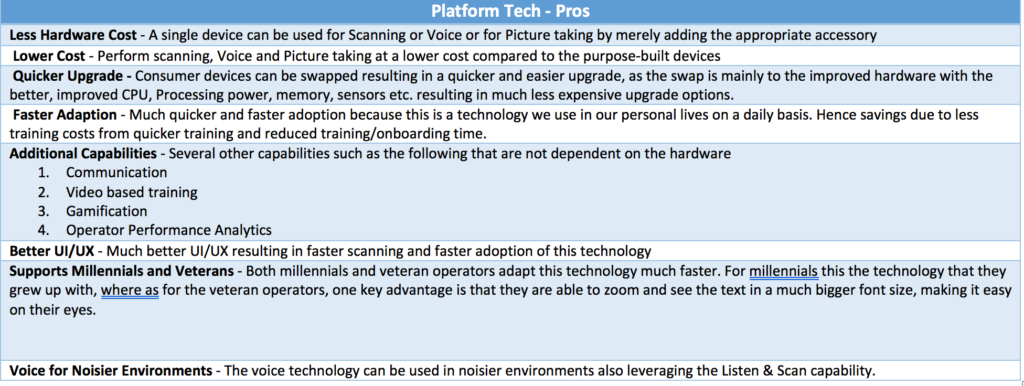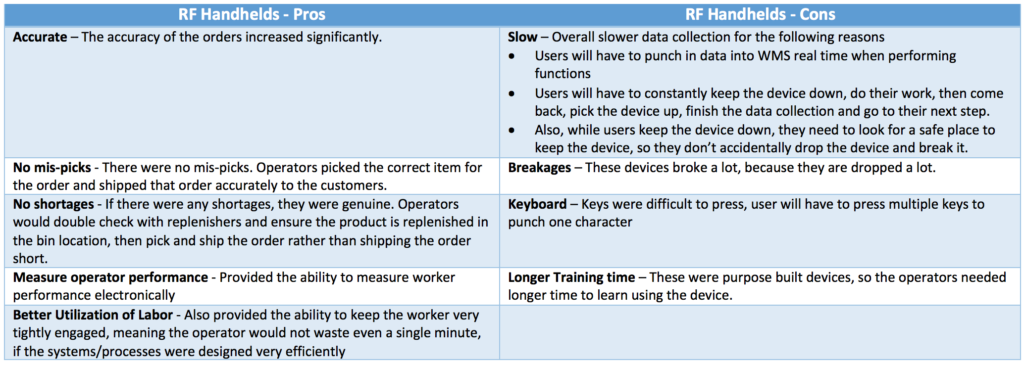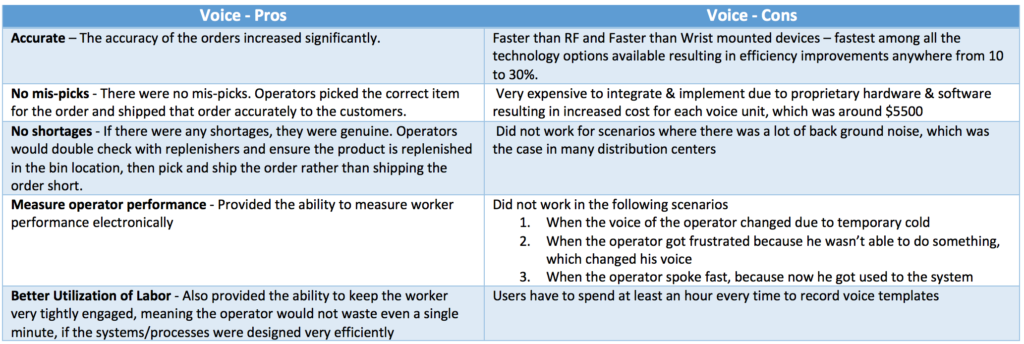Evolution of Data Collection Tech in DCs
Data Collection in Warehouses
Data collection is a very important business function that needs to be performed in a Distribution Center in order to maintain accurate inventory count real time of all the SKUs that a distribution center ships for all its customers. Hence all the processes that are performed reflect inventory count real time and hence orders can be fulfilled at a much faster pace, without shortages, without mispicks and delivering the highest levels of customer satisfaction that truly depicts a key facet of any brand.
Data collection in warehouses really started with pen and paper. DC Managers built processes around what data needs to be collected, trained their personnel, had them collect data using a pen and a paper typically with a writing pad. And it involved a lot of printing, and most of the picking was done based on paper pick documents that were printed from printers called pick tickets, pickers would collect those pick tickets and go picking product from different locations, where these products were housed, marking back orders and short picks in their paper documents, then bring them to a verification station where the pickers themselves or a packer would scan the picked item and report the quantity picked into the system cross checking against the paper pick documents, then a packing list will be printed for the customer that would go into the box and the box gets shipped after verification and after application of the appropriate retailer and/or carrier shipping label. There was a lot of paper, generating reports form those big dot matrix printers, eventually the labels came along and the labels made it easy to mark the boxes that were bound for customers and or stores. Then came the barcodes and the scanners to scan those barcodes. Then came voice, now vision picking seems to be the next, but still it has some way to go until it gets fully adapted.

Paper Based Processes:
- This involved operators writing down everything they do in a paper in a pad with a pen and/or pencil.
- This would also involve pre-printed pick sheets, work assignments (sometimes with sticker labels), that would be printed in bulk. Then the pickers would take those sheets, perform the picking processes, then would bring the product to a work station, where they would verify the product and the inventory they picked by reporting that to the WM (Warehouse Management) system
- The supervisors and/or managers came up with the processes & then they trained their operators and followed these steps diligently.
RF Handhelds:
- This involved users logging on to RF hand held guns, also called as Bricks or Guns and then performing functions such as picking, receiving, sorting, Putaway etc.
- These guns were originally designed and deployed for retail stores, where the store associates would count product to ensure the inventory count is accurate for inventory management purposes on a need basis.
- The same device was deployed in the warehouse even though the nature of the job that was done in the warehouse was much different, because the warehouse operators were doing the inventory count, moving boxes, moving pallets, moving product/merchandise etc all the time. So it is really paramount to make sure the device they used worked very well and was very efficient
- Also the labor cost is the primary cost for an DC operation and could range anywhere from 50% to 70% of the overall operating cost. Hence it is very important to reduce labor cost in the DC.
- These devices were specially built devices for this specific purpose. These devices also had an integrated barcode scanner. These devices had a mini computer that was running Windows CE operating system. These devices also required a software called Terminal Emulation software, that emulated a console screen in the mini computer.
- The price of these devices that are new are from $2000 to $3500
- The price of these devices that are used or refurbished are anywhere from $800 to $1500. Retailers & distributors with thin margins use these refurbished devices to accommodate their budget situations.
Wrist Mounted Devices:
- The wrist mounted devices were introduced in order to make these operators efficient, the concept was to make the operators hands free, so they don’t need to carry the RF hand held device in their hand, they don’t have to keep the device down and pick it back up, instead they will wear the device in their arm all the time, so that way both their hands were available to carry boxes, or drive equipment or pick product
- These devices were made by the same vendors that made the RF handheld devices. These devices were supposed to free up the other hand completely, but in reality they provided only a couple of extra fingers, instead of adding an extra free hand, so these devices were never fully adopted
- The price of these devices that are new are from $3000 to $4500
- The price of these devices that are used or refurbished are anywhere from $1400 to $1500. Retailers & distributors that sell low cost merchandise often use these refurbished devices to accommodate their low budget situations.
Voice Technology:
- Voice technology as supposed to be game changing for the warehousing and distribution industry
- Voice was a great option for picking, because it made the operator hands free & eyes free, meaning the operator was able to use both his hands because he didn’t have to carry anything in his arms, also the operator has no need to look at the device’s screen because he was able to take the instructions from the voice system through the headset, which means even more time saved.
- The price of these devices that are new are from $4000 to $5500
- These systems also required proprietary software, which increase the cost of implementation
Vision Picking Systems:
- There are a new set of companies that have emerged, that provide this capability called vision picking. Basically these devices leverage a smart glass that looks like google glass, with heads up display. The operators would look at the data in a screen that is shown in the google glass form factor and then perform scanning using a ring scanner that is worn in their fingers
- Even though Vision picking solutions sound very attractive, they are not as fast as voice picking. There are retailers and distributors that are doing pilots, but no widespread adoption has taken place yet.
- The reason is because this is a technology that people are not used to in their daily lives, so takes longer time to adapt to, hence it increases the training time, which results in increased cost to deploy such a product.
- This will gain impetus and faster adoption after an AR glass that is widely adapted in the consumer market is launched. Then developing a solution for warehouses leveraging such a consumer AR glass will help with much faster adoption in the warehouse. There are some AR glasses that are being worked on by Vuzix & ODG, but they are not fully launched yet in the consumer market and hence not widely adapted in the consumer market yet.
Platform based Approach – Smart Gladiator:
- One key vendor in this space is Smart Gladiator, based out of the Advanced Tech Dev Center out of the Georgia Tech located in the Tech Square area in the heart of the City of Atlanta
- The platform based approach leverages the consumer mobile device, ruggedizes it for warehouse use & incorporates all other capabilities using software as a platform, taking advantage of the different capabilities that are available in the consumer mobile device.
- The platform can support almost all the requirements such as the following
- Basic scanning as a wearable terminal
- Basic Scanning as a Handheld
- Gamification
- Voice enabling using the same hardware
- AR in the future
- Tablet technology for the supervisors & managers
- This vendor has developed software that is highly intuitive, user friendly with consumer style UI/UX providing several benefits.
- Low cost compared to the purpose built devices with significantly more capabilities such as the following
- Easy Communication between the operators and supervisors
- Video based training for new operators
- Fast Charging with reduced weight of the device resulting in lesser stress on the arms of the operators
- Devices can be voice enabled just by turning on a flag in the software and adding a headset. One platform to provide all the mobile capabilities to your supply chain that include the following
- Wearable with ring barcode scanner
- RF Handheld leveraging Cognex shell
- Tablets for Trucks in the warehouse
- Terminal Emulation
- Voice Enabling the whole solution
- Gamification
- Image Enabling the Supply Chain

Originally published at Smartgladiator.com on Aug 22, 2017.








 1. Increases EPP, using budgeted line items.
1. Increases EPP, using budgeted line items. Millennial friendly technology, less onboarding time, very easy adoption – touch screen keypad, and 43% of Millennials already use IOS, familiar with Facetime, 85% of Millennials aged 18-24 own devices and 86% aged 25-34 own them, consume a lot of video on their smartphones, and are highly comfortable with this medium, they understand and like apps.
Millennial friendly technology, less onboarding time, very easy adoption – touch screen keypad, and 43% of Millennials already use IOS, familiar with Facetime, 85% of Millennials aged 18-24 own devices and 86% aged 25-34 own them, consume a lot of video on their smartphones, and are highly comfortable with this medium, they understand and like apps.
Thanks for sharing. I read many of your blog posts, cool, your blog is very good.